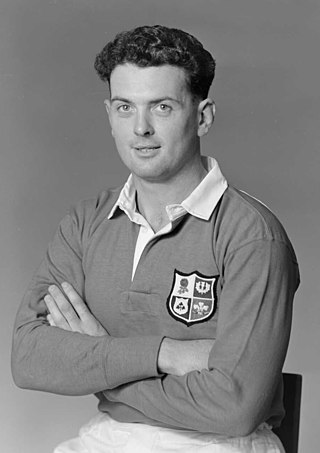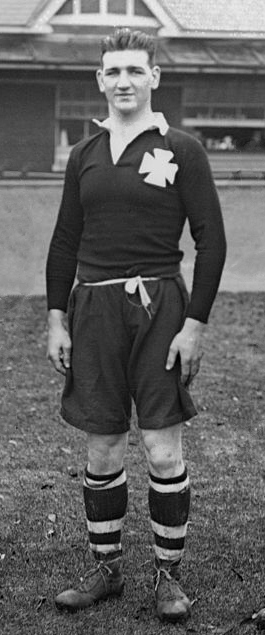
Barry John was a Welsh rugby union fly-half who played in the 1960s and early 1970s during the amateur era of the sport. John began his rugby career as a schoolboy playing for his local team Cefneithin RFC before switching to the first-class west Wales team Llanelli RFC in 1964. Whilst at Llanelli, John was selected for the Wales national team—as a replacement for David Watkins—to face a touring Australian team.
| repyears1 = | repyears2 = 1953–1961 | repyears3 = 1959 | repcaps1 = | repcaps2 = 21 | repcaps3 = 2 | reppoints1 = | reppoints2 = 50 | reppoints3 = 5 | ru_ntupdate = | coachteams1 = | coachyears1 = | ru_coachupdate = | occupation = timber-merchant | relatives = Len Davies (brother) }}

John Rees Glyn Stephens was a Welsh international rugby union player who played club rugby for Tonmawr RFC and Neath. He won 32 caps for Wales and was selected to play in the British Lions on the 1950 tour of Australia and New Zealand. He was the son of a past Welsh rugby international, Glyn Stephens, who was also president of the Welsh Rugby Union.

Tom Arthur was a Welsh international rugby union lock who played club rugby for Neath and was capped 18 times for Wales. A tough second row forward with a strong physique, Arthur was often criticised for being over-vigorous. Though his style of play was fairly typical for Welsh rugby at the time.

Jack Bassett was a Welsh international rugby union full back who played club rugby for Penarth. He won 15 caps for Wales and was selected for the 1930 British Lions tour of Australia and New Zealand. He captained the Welsh team on nine occasions.
Thomas Rees was a Welsh international rugby union prop who played club rugby for Newport RFC. He was a member of the winning Welsh team who beat the 1935 touring All Blacks.
Charles "Tal" Harris was a Welsh international rugby union scrum-half who represented Wales and played club rugby for Aberavon.
Glyn Prosser was a Welsh international rugby union flanker who played club rugby for Neath, and was capped four times for Wales. An aggressive wing forward, Prosser is best known for being a member of the Wales team that beat the touring New Zealanders in 1935.

William Rex Willis was a Welsh international rugby union scrum-half who played club rugby for Cardiff and invitational rugby for the Barbarians. He won 21 caps for Wales and was selected to play in the British Lions on the 1950 tour of Australia and New Zealand.

Clifton Davies was a Welsh international prop who played club rugby for Cardiff and invitational rugby for the Barbarians. He won 16 caps for Wales and was selected to play in the British Lions on the 1950 tour of Australia and New Zealand.

Dai Parker was a Welsh international rugby union prop who played club rugby for Swansea. He won ten caps for Wales and was selected to play in the 1930 British Lions tour of New Zealand and Australia.
Walter Vickery was an international rugby union back row who represented Wales and played club rugby for Aberavon. His father, George Vickery, also played for Aberavon and was also an international player, but he was capped for England.
Charles Henry Pugh was a Welsh international rugby union player who played rugby for three notable Welsh clubs, Aberavon, Maesteg and Neath. He was capped seven times for Wales and was part of the Welsh team that faced the touring 1924 New Zealand team.
David 'Dai' Hiddlestone was a Welsh international rugby union player who played club rugby for Neath. He was capped five times for Wales and was notable for leading an ill-advised response to the New Zealand Haka during the team's 1924 tour.
William Davies, also known by the nickname of "Avon", was a Welsh dual-code international rugby union, and professional rugby league footballer who played in the 1910s and 1920s. He played representative level rugby union (RU) for Wales, and at club level for Aberavon and Swansea as a centre, and representative level rugby league (RL) for Great Britain and Wales, and at club level for Leeds, as a wing.
Glamorgan County RFC is a Welsh rugby union club that manages an invitational team, known as Glamorgan that originally played rugby at county level. The team is made up of amateur players from sports clubs in the Glamorgan region and historically played matches against other county teams from Wales and England, and during the 20th century was a key fixture for touring international teams. Today the club manages Glamorgan's premier rugby union tournament, the Glamorgan County Silver Ball Trophy, and arranges invitational Glamorgan teams to face Welsh rugby clubs during celebrations, such as anniversaries.
John Charles Meredith Dyke was a former Wales international rugby union fullback. Dyke made his debut for Wales on 1 December 1906 versus South Africa and was selected for the 1908 British Lions tour to New Zealand and Australia. He played club rugby for Penarth and London Welsh.
Clifford Williams was a Welsh international rugby union hooker who played club rugby most notably for Llanelli and Cardiff. Williams played two matches for Wales, against New Zealand in 1924 and England in 1925.
Johannes Karl "Chum" Ochse was a South African rugby union wing. Ochse played club rugby for Paarl and provincial rugby for Western Province. Ochse was capped seven time for the South African national team and was a member of the 1951–52 South Africa rugby tour of Great Britain, Ireland and France. He finished the tour as his country's highest try scorer.
Albert Charles Keevy, better known as Jakkals Keevy, was a South African rugby union player, most often playing as a fullback, though sometimes utilised at flyhalf. Keevy played club rugby for Brakpan and provincial rugby for both Orange Free State and Eastern Transvaal. Although he was never capped for the South African national team he is still considered a Springbok as he undertook the 1951–52 South Africa rugby tour of Great Britain, Ireland and France. He represented South Africa in thirteen games of the tour, which saw the Springboks lose only once in 31 matches.







